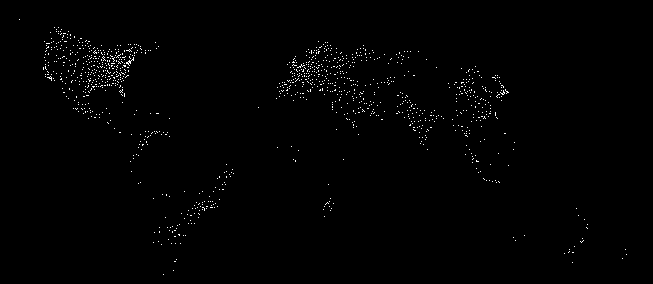
Steven Brakman, Harry Garretsen, and Charles van Marrewijk |
Zipf's Law, or the Rank-Size Distribution
"Zipf's Law" is the name of a remarkable regularity in the distribution of city sizes all over the world, also known as the "Rank-Size Distribution". Take, for example, Amsterdam, the largest city in the Netherlands and give it rank number 1. Then take the second largest city, Rotterdam, and give it rank number 2. Keep on doing this for those cities for which you have data available, possibly selecting only cities exceeding a certain minimum size. If you calculate the natural logarithm of the rank and of the city size (measured in terms of the number of people) and plot the resulting data in a diagram you will get a remarkable log-linear pattern, this is the Rank-Size Distribution. If the slope of the line equals minus 1, as is for example approximately the case for the USA, India, and France, the relationship is known as Zipf's Law.
There is also a website devoted to Zipf's Law, see http://www.nslij-genetics.org/wli/zipf/
The remarkable log-linear relationship of the city-size distribution holds for virtually all countries. To demonstrate this, we have collected data on the city-size distribution for many countries, calculated Zipf's Law, and illustrated it in a figure. The results, containing cities with more than 100,000 inhabitants, are made in the Microsoft Office Excel '97 files downloadable below. The files distinguish between measurements of the "city proper" and the "urban agglomeration". When available the latter estimates of city sizes gives a more reliable view of Zipf's Law.
To use the files below you must have available either internet explorer or a version of Microsoft Office Excel '97 or up.
To use the files below you must have available a version of Microsoft Office Excel '97, or a more recent version. Download all files and place them in the same folder. Opening the "index" file will make the data available in the other files easily accessible.
|
america.xls (405 kb) |
europe.xls (531 kb) |
asia.xls (658 kb) |
africa.xls (211 kb) |
If you want the files to be easily accessible, do the following:
- download all files above as files ('save as'), including this index.xls (237 kb) file
- place all files in the same folder
- opening the "index" file with Excel will now make the data available in the other files easily accessible.
The image below (composed of several satellite pictures) gives an idea of the degree of economic agglomeration in the world economy.

In Chapter 7 of our
book and also elsewhere on this website we discuss and present estimations of
the so-called rank-size rule. Based on UN data we typically find the Pareto
exponent to differ from 1 which means that the strict version of the rank-size
rule a.k.a. Zipf’s Law does not hold for most countries. Our findings are in
line with the main findings by Rosen and Resnick (1980) which was until very
recently probably the most extensive study on the rank size rule. Until
recently, that is to say until the paper by Kwok Tong Soo (2002) came along.
Using a new data set on 75 countries Soo finds the Pareto exponent (the q
coefficient in Chapter 7) to be 0.90 for cities proper and 1.17 for urban
agglomerations (based on a smaller sample and data that are not as good as in
Soo (2002), we find these coefficients to be respectively 0.88 and 1.05). In his
study Soo also provides estimations for various primacy ratios and finds these
primacy ratios to be only weakly related to the Pareto exponent. In line with
the work by for instance Ades and Glaeser (1995) (see Box 7.3 in Chapter 7), Soo
also finds that variations of the Pareto exponent are better explained by
poltical variables than by economic geography variables like proxies for
economies of scale or transportation costs.
Kwok Tong Soo, 2002,
Zipf’s Law for Cities: A Cross Country Investigation, mimeo.
The data set used in Soo's study is complied by Thomas Brinkhoff, City Population, http://www.citypopulation.de
A complete recent overview of city size distributions and the determinants of urban growth is provided by Xavier Gabaix and Yannis Ioannides:
"The evolution of city size distributions," to be published in J.V. Henderson and J.F. Thisse, Handbook of Urban and Regional Economics, North Holland.
In a recent paper Jeroen Hinloopen and Charles van Marrewijk (2006) document the relationship between the Rank-Size Rule / Zipf's Law and the phenomenon of Revealed Comparative Advantage (as measured by the Balassa index) in international trade flows.
Abstract
Using a comprehensive international trade data set we investigate empirical regularities (known as Zipf’s Law or the rank-size rule) for the distribution of the interaction between countries as measured by revealed comparative advantage. Using the recently developed estimator by Gabaix and Ibragimov (2006) we find strong evidence in favor of the rank-size rule along the time, country, and sector dimension for three different levels of data aggregation. The estimated power exponents that characterize the distribution of revealed comparative advantage are stable over time but differ between countries and sectors. These differences are related empirically to country and sector characteristics, including population size, GDP, and factor intensities.
This page is maintained by Charles van Marrewijk. comments home page